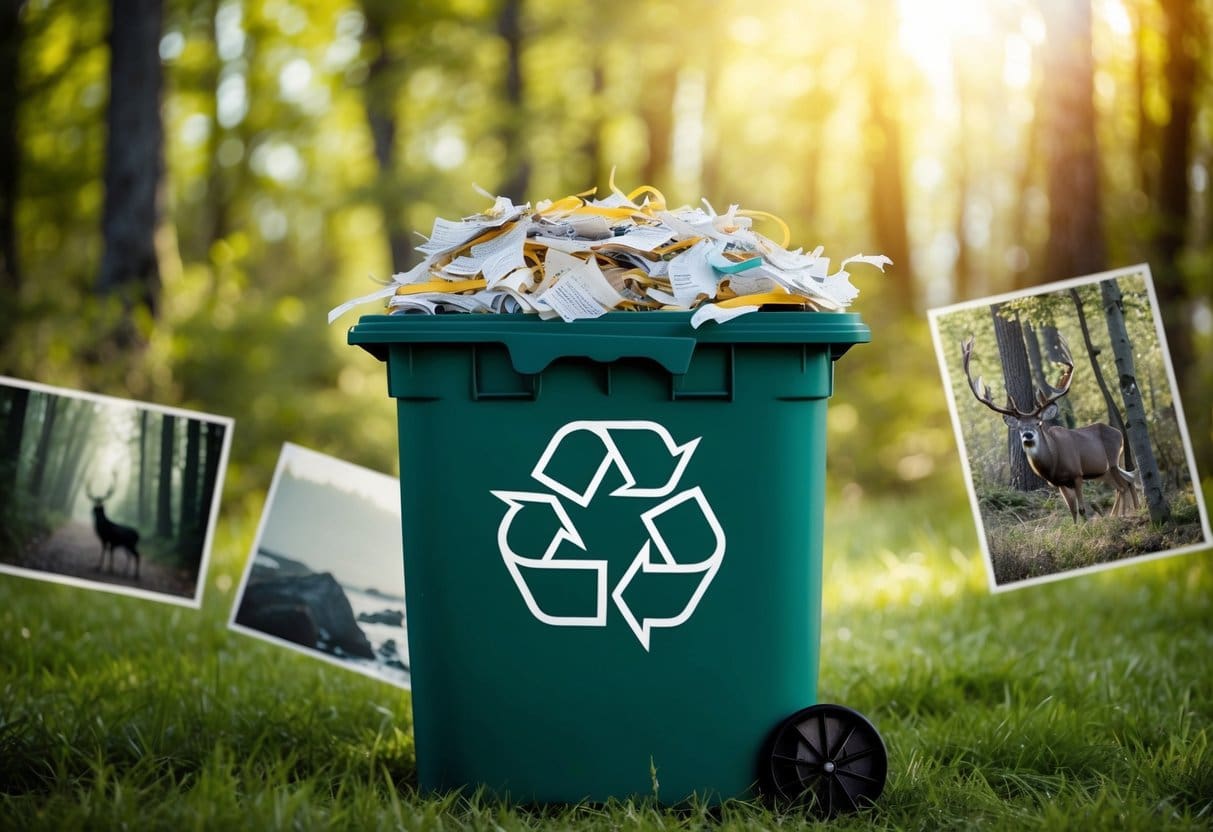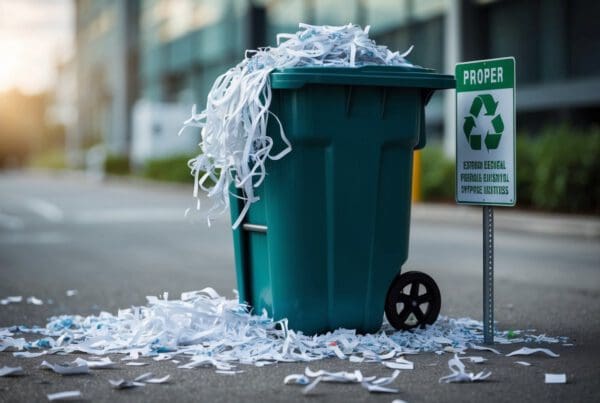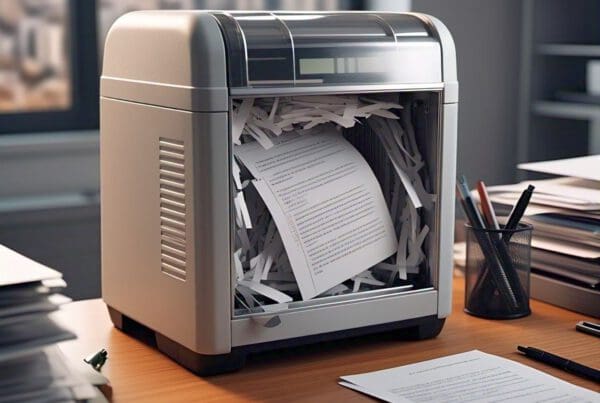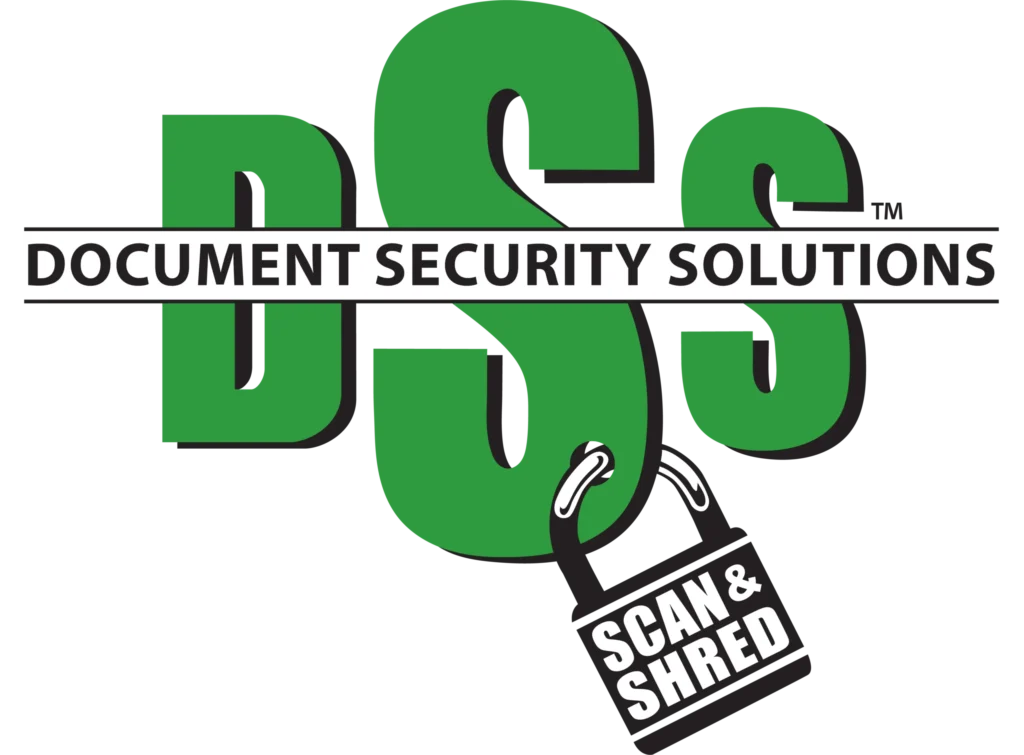Overview of Shredded Paper Disposal

Shredded paper disposal involves understanding its role in waste management and environmental impact. We need to consider how shredding affects paper products and the best practices for handling shredded paper waste.
Shredding and Its Purpose
Shredding is used to protect sensitive information. It breaks down paper documents into small pieces, making it difficult to retrieve data. This process is crucial for businesses and individuals who handle confidential material.
While shredding helps in data security, it alters the recyclability of paper. Shredded paper fibers are shorter and less suitable for recycling into new paper products. We need to be cautious about how paper shredding fits into larger paper disposal and waste management systems to minimize any negative environmental impact.
Shredded Paper in Waste Management
When managing shredded paper waste, it’s important to know that it can mix with other waste and become contaminated. This contamination affects its recyclability. Placing shredded paper in separate waste streams or clear bags can help.
Some recycling centers treat shredded paper differently based on fiber length. We need to follow local guidelines for effective disposal. Composting is an option, too, where shredded paper adds valuable carbon. Understanding these methods helps us make informed choices about its disposal, reducing its environmental footprint.
Recycling Processes and Impact
In this section, we explore how shredded paper finds a new life as recycled products, the difficulties in processing shredded materials, and how we can enhance recycling efforts for better sustainability. These aspects help us understand the importance of efficient recycling.
The Journey of Shredded Paper to Recycled Products
Once shredded paper reaches recycling centers, it begins its journey to becoming new products. Recycling centers first sort shredded paper into bins. Then, the paper goes through a washing process to remove ink, glue, and other contaminants. This clean pulp is blended with water to create a slurry.
Next, the paper fibers in the slurry are pressed and dried. This process turns the slurry into usable sheets. These sheets become recycled paper products like tissues, packaging, and office paper. Recycling shredded paper helps us reduce waste and conserve resources.
Using shredded paper in recycling programs supports sustainability. It ensures fewer trees are cut down and reduces landfill waste. Our efforts in recycling help protect natural habitats and conserve energy.
Challenges in Recycling Shredded Paper
Recycling shredded paper presents some challenges. Shredded paper fibers are often shorter and weaker. This makes them less ideal for producing high-quality paper products. Sorting shredded paper from other materials can also be tricky. Many recycling centers handle mixed waste, so it’s hard to separate shredded paper effectively.
Mismanagement in recycling programs can lead to contamination. This lowers the quality of recycled paper and reduces the eco-friendliness of the products. Identifying ways to improve sorting is crucial to overcome these hurdles.
Additionally, some recyclers may not accept shredded paper. This is due to the challenges in handling and processing it. Raising awareness about the acceptance criteria and enhancing recycling programs can motivate us to recycle more efficiently.
Improving Recycling Efficiency
To improve recycling efficiency, we need innovative processes. Introducing specialized machines for sorting and processing shredded paper can make a big difference. By investing in new technologies, we can enhance recycling centers’ capabilities.
Educating the public on best practices for recycling shredded paper is crucial. Proper disposal and preparation can ensure smoother recycling processes. Clear instructions in recycling programs can guide us in this effort.
Establishing stronger partnerships with organizations that create recycled products can also help. Collaborations can promote sustainability and bring us closer to achieving high eco-friendly standards. These efforts are essential for a more sustainable future.
Environmental Considerations of Shredded Paper

Shredded paper disposal comes with specific environmental concerns. We focus on energy and emissions from the shredding process, and how these affect ecosystems and climate. Understanding these can shed light on the broader impact of disposals.
Energy and Emissions in Paper Shredding
The shredding process consumes a significant amount of energy. As we shred paper, machines require electricity, which can lead to an increase in energy demand. Electricity usage contributes to emissions, including greenhouse gases, which impact climate change. Managing this energy consumption can help reduce our carbon footprint.
It’s important that we consider energy-efficient shredders. These machines use less power, saving energy and reducing emissions. Investing in such equipment supports environmental sustainability by cutting down on unnecessary energy usage.
Impact on Ecosystems and Climate
The effect of shredded paper on ecosystems is an essential point. When disposed of improperly, shredded paper can contribute to air and soil pollution. As it breaks down, paper can release methane, a potent greenhouse gas affecting climate change.
To lessen this impact, we must follow environmental regulations and recycle shredded paper responsibly. This can help minimize harm to ecosystems and reduce the environmental impact of paper disposal. Recycling initiatives improve sustainability, allowing us to mitigate damage and promote a healthier climate.
Sustainable Alternatives and Best Practices
We need to focus on ways to dispose of shredded paper that are friendly to the environment. These methods can help reduce waste and promote sustainability.
Composting of Shredded Paper and Its Benefits
Composting shredded paper is an effective way to handle waste while enriching the soil. Shredded paper breaks down quickly in composting bins, acting as a carbon source and balancing nitrogen-rich materials like food scraps. In our gardens, this practice keeps soil healthy.
When we choose composting, we not only reduce landfill waste but also support eco-friendly practices. Compost improves soil structure and retains moisture, reducing the need for chemical fertilizers. By incorporating shredded paper into our composting routine, we contribute to a sustainable cycle that benefits our communities.
Corporate Responsibility in Paper Usage
Corporations can play a major role in minimizing paper waste. Implementing policies that encourage responsible paper use can significantly impact our carbon footprint. Printing double-sided, using digital documents, and encouraging recycling are practical steps businesses can take.
Through corporate social responsibility, companies have the ability to promote sustainable practices. This includes engaging employees in recycling programs and educating them about the effects of paper waste. By committing to these strategies, companies show leadership in preserving our environment.
Embracing Circular Economy in Paper Production
The circular economy offers a way for us to rethink paper production and use. In a circular economy, paper products are reused, remanufactured, or recycled, creating a closed-loop system. This minimizes waste and maximizes resources.
Incorporating a circular economy mindset in paper production demands innovative solutions. Manufacturers can focus on creating paper products from recycled materials and ensuring products are biodegradable. By making these changes, we support lifelong usability and sustainability.
Legal and Privacy Aspects of Document Shredding
Document shredding plays a crucial role in keeping sensitive information private and ensuring legal compliance. We must understand the importance of secure shredding services to prevent identity theft and adhere to environmental regulations.
Protecting Sensitive Information Through Secure Shredding
We all handle documents containing personal and sensitive data. If not properly destroyed, these papers pose a risk of identity theft and privacy breaches. Secure shredding helps protect our information by irreversibly destroying paper records.
Benefits of secure shredding are;
- Prevention of Identity Theft: Ensures confidential data isn’t misused.
- Compliance with Privacy Laws: Meets legal requirements for data protection.
- Peace of Mind: Knowing that our sensitive information is safe.
Using secure shredding services or paper shredding machines ensures that documents are disposed of responsibly and confidentially. This step is essential in preventing unauthorized access to sensitive information.
Shredding Services and Compliance with Environmental Laws
While protecting privacy, shredding must also comply with environmental regulations. Shredding services can help by offering eco-friendly solutions, ensuring that paper waste is handled properly.
Key compliance factors include;
- Recycling Practices: Efficient recycling of shredded paper.
- Reduced Carbon Footprint: Use of energy-efficient equipment.
We must choose secure document destruction services that offer environmentally friendly shredding processes. This way, we protect our privacy and adhere to legal and environmental standards.
By selecting the right paper shredding service, we contribute to data security and the well-being of our planet.





